Tungsten Steel Electric Rolling Mill Jewelry
SuperbMelt Precision Gold, Silver, and Alloy Sheet Rolling Mill
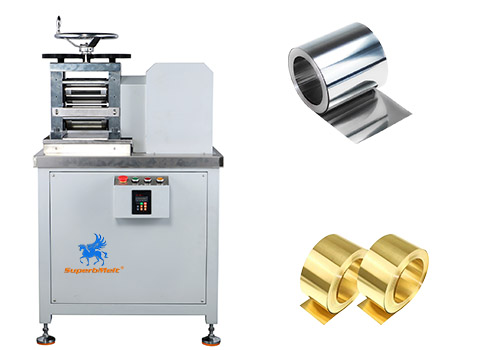
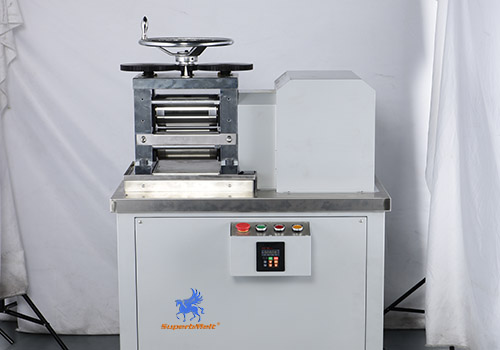
SuperbMelt Electric Rolling Mill Jewelry uses tungsten steel rollers to roll metal sheets, producing surfaces that are smoother and more uniform in thickness to achieve a mirror effect. It is suitable for high-quality jewelry manufacturing and metalworking industries.
Compared to traditional rolling mills, the SuperbMelt tungsten steel rolling mill has a longer lifespan, is less prone to damage, and effectively reduces the frequency of machine replacement and maintenance, thereby lowering production costs.
The SuperbMelt rolling mill is specifically designed for rolling various precious metals, including gold, silver, platinum, and alloys, with thicknesses ranging from 9mm to 0.1mm, helping jewelry manufacturers meet various design and manufacturing needs.
| Model number | SPB–YX-5.5P |
| Power source | 3 phase 380V, 50/60Hz |
| Power | 4 kw |
| Applicable metal | Gold, Silver, Platinum, Palladium, and their alloys |
| Sheet thickness | 9-0.1mm |
| Sheet width | Within 30mm |
| Lubrication method | Automatic oil supply |
| Rotating speed | 22 rpm |
| Dimensions | 530*600*1380mm |
| Weight | 270KG |
| Final size | (D*L)105*200mm |
- High Precision Rolling: With thicknesses ranging from 9 to 0.1 mm, the machine guarantees precision rolling of a variety of precious metal materials, giving exact control over the final product requirements.
- Tungsten Steel Mirror Rollers: The mill uses tungsten steel mirror rollers to create metal sheets with consistent thickness and smooth surfaces, giving the finished product a mirror-like polish.
- Versatility: Suitable for a wide range of jewelry production applications, it can process a number of precious metal materials, including gold, silver, platinum, and alloys.
- Extended Lifespan: In comparison to traditional rollers, tungsten steel rollers have a longer lifespan. This means that less frequent replacement and maintenance are required, which improves operating efficiency and lowers downtime.
- Cost-effectiveness: The machine provides jewelry producers with cost-effective solutions that enable them to increase output and profitability by minimizing maintenance expenses and downtime related to roller replacement.
- User-friendly Design: With its intuitive controls and interfaces, the machine is easy to operate and suitable for operators of all skill levels.
- Jewelry Manufacturing: To roll and process precious metals like gold, silver, platinum, and alloys into sheets of the right thicknesses for creating beautiful jewelry pieces, the machine is widely employed in the jewelry industry.
- Metalworking Industry: The precise rolling capabilities it offers enable the production of metal sheets with consistent thicknesses, which are utilized in the manufacturing of elaborate metalwork patterns, parts, and components.
- Craftsmanship and Artistry: Using a rolling mill, artisans and craftsmen may precisely regulate the thickness and quality of metal sheets to make sculptures, elaborate metalwork designs, and artistic items.
- Design and Prototyping: During the product development phase, designers and engineers test various metal finishes and thicknesses for new jewelry designs and metalworking projects by using the machine for experimentation and prototyping.
- Educational Institutions: To provide students practical experience in metal production, educational institutions and training centers include the electric rolling mill into their curricula to teach metalworking processes, jewelry creation, and craftsmanship.
- Research and Development: It is used at labs and facilities dedicated to this type of work to investigate novel methods for processing metal and making jewelry, as well as to examine the characteristics of precious metals.
Why SuperbMelt Electric Rolling Mill Jewelry



Any Question About SuperbMelt Electric Rolling Mill Jewelry

2 years warranty
The warranty for our machine is one year longer than the warranty provided by other factories.

ISO CE SGS approved
Professional certification bodies certify that the machines are of high quality.

Strong service team
We will give response within 24 hours against your problem by our professional engineer.
More Gold Melting and Casting Machinery For Your Choice
Any Question About SuperbMelt Electric Rolling Mill Jewelry
Guide to SuperbMelt Electric Rolling Mill Jewelry
Comparison between conventional roller mill and tungsten steel roller mill
- Durability: Because tungsten steel is harder and more resistant to wear than ordinary roller mills, tungsten steel roller mills last longer.
- accuracy: The rolling process is carried out with more accuracy in tungsten steel roller mills, which produces rolled material with smoother surfaces and more uniform thickness.
- Surface Finish: Using tungsten steel rollers frequently produces rolled material with a finer surface finish, producing a mirror-like effect that improves the end product’s look.
- Cost-effectiveness: Although tungsten steel roller mills may initially cost more, their longer lifespan and better performance can result in long-term cost benefits by lowering replacement and maintenance costs.
- Versatility: Tungsten steel roller mills are adaptable instruments with a variety of uses in the jewelry-making and metalworking sectors. They can roll a broad range of materials, including precious metals like gold, silver, platinum, and alloys.
How an electric rolling mill can be used for jewelry making and metalworking projects
Sheet and Wire Rolling: Rolling metal sheets and wires to precise thicknesses and dimensions is one of the main applications of an electric rolling mill. It can be used by jewelry manufacturers to thin out metal sheets or wires to build components that fit their designs precisely.
Texturing and Patterning: Textured rollers are a common feature of electric rolling mills, allowing metal surfaces to be covered in a variety of patterns and textures. This enables designers of jewelry to incorporate ornamental features like hammered textures, grooves, or elaborate patterns into their creations.
Wire Drawing: Metal wires may be drawn to smaller diameters using electric rolling mills that are outfitted with wire drawing accessories. This is helpful for producing thin, uniformly-thick tiny wires for small jewelry elements like ear wires, clasps, or elaborate wirework patterns.
Flat and Wire Forming: Metal sheets and wires can also be bent and formed into the appropriate shapes and forms using electric rolling mills. This involves shaping wires into loops, coils, or other geometric patterns, or shaping flat sheets into curved or domed shapes for components like bezels.
Thickness Reduction and Annealing: Electric rolling mills are not only useful for shaping metal, but they may also be used to reduce the thickness of metal sheets or wires by making several passes at a time. Additionally, the rolling process can work-harden the metal, increasing its strength and durability. The metal can next undergo annealing, a heat treatment procedure, to soften it and make it more ductile.
Patterned Metal Sheets: Electric rolling mills may create patterned metal sheets that are suitable for use as ornamental components in jewelry-making by fusing their texturing and rolling capabilities. These patterned sheets may provide surface decorations, overlays, and inlay work in jewelry creations more visual intricacy and intrigue.
The difference between electric rolling mill and manual rolling mill
Metal may be shaped using both an electric and a manual rolling mill, although their modes of operation differ because of the power supply and degree of automation:
Energy Source:
Electric Rolling Mill: An electric rolling mill gets its power from electricity, as the name implies. Usually, a motor powers the rollers, enabling steady and uninterrupted functioning.
Manual Rolling Mill: In contrast to an electric motor, a manual rolling mill lacks one. The rollers are moved by the operator using human force.
Effectiveness and Velocity:
Electric Rolling Mill: Because the motor can exert a steady, strong force on the metal, enabling faster operations, electric mills are often more productive and faster than manual mills.
Manual Rolling Mill: The operator must exert more effort and work more slowly with manual mills. The strength and stamina of the individual running the mill determine the speed and force used.
Regulating and Accurate:
Electric Rolling Mill: Electric mills are frequently equipped with variable speed controls, which enable the operator to precisely control the rollers’ force and speed. For even more accuracy, certain versions could additionally feature digital controls.
Manual Rolling Mill: For some activities where the operator requires a high level of tactile feedback, manual mills provide direct, hands-on control that can be advantageous. However, human error and weariness can make maintaining constant accuracy more difficult.
The Price and Complexity:
Electric Rolling Mill: Due to the additional expense of the motor, electrical components, and sometimes more complex design, electric mills are typically more expensive than manual mills. They can also need a power source and further upkeep.
Manual Rolling Mill: Manual mills are more cost-effective and simpler to construct, which makes them a better choice for small workshops or amateurs. They don’t need a power source and are also simpler to maintain.
Uses and Adequacy:
Electric Rolling Mill: Electric mills are ideal for industrial settings where productivity and speed are critical, such jewelry making, metalworking shops, and other manufacturing settings.
Manual Rolling Mill: Those who enjoy hands-on work and are prepared to put in more physical effort and slower pace—jewellers, metal artists, and hobbyists—are the main users of manual mills.
FAQ Guide of Electric Rolling Mill Jewelry
- 1. What types of metals can be used with an electric rolling mill?
- 2. How do I adjust the rollers to achieve the desired thickness?
- 3. What safety precautions should I take when using an electric rolling mill?
- 4. Can I use an electric rolling mill to pattern metal?
- 5. How do I maintain and lubricate the rollers of an electric rolling mill?
- 6. What are the benefits of using an electric rolling mill over a manual one?
- 7. How do I clean the metal after rolling it through the mill?
- 8. What are some common uses for an electric rolling mill in jewelry making?
- 9. Can an electric rolling mill be used to combine different metals?
- 10. What size and type of electric rolling mill should I choose for my jewelry-making needs?
- 11. How do I prevent metal from sticking to the rollers?
- 12. Can an electric rolling mill be used to create wire?
- 13. How do I troubleshoot issues with my electric rolling mill?
- 14. Can I use an electric rolling mill to anneal metal?
- 15. How do I transport and store my electric rolling mill?
- 16. What should I do if my electric rolling mill stops working?
- 17. Can an electric rolling mill be used to shape non-metallic materials?
1. What types of metals can be used with an electric rolling mill?
Most non-ferrous metals, including gold, silver, copper, and brass, are suitable for rolling. Always check the manufacturer’s guidelines for specific metal compatibility.
2. How do I adjust the rollers to achieve the desired thickness?
Each rolling mill has a different method for adjusting the rollers. Refer to the user manual for instructions on how to set the rollers to the appropriate gap for your metal thickness.
3. What safety precautions should I take when using an electric rolling mill?
Always wear appropriate safety gear, such as gloves and safety glasses. Ensure the metal is cool before handling it, and never operate the mill with any part of your body in the roller area.
4. Can I use an electric rolling mill to pattern metal?
Yes, you can use a rolling mill to pattern metal by placing a patterned sheet of metal between the rollers. This process is known as “pattern rolling.
5. How do I maintain and lubricate the rollers of an electric rolling mill?
Follow the manufacturer’s recommendations for lubrication. Generally, you’ll need to apply a thin layer of oil to the rollers after each use to prevent rust and wear.
6. What are the benefits of using an electric rolling mill over a manual one?
- Electric rolling mills are faster and more consistent, allowing for greater productivity. They also require less physical effort, making them ideal for heavy-duty metalworking tasks.
7. How do I clean the metal after rolling it through the mill?
Use a wire brush or steel wool to remove any burrs or marks left by the rolling process. Then, clean the metal with a mild detergent and water, followed by a polish to bring out the shine.
8. What are some common uses for an electric rolling mill in jewelry making?
Rolling mills are used to reduce the thickness of metal, create patterns, and combine layers of metal. They are also useful for texturing metal and creating wire.
9. Can an electric rolling mill be used to combine different metals?
Yes, you can combine different metals by rolling them together through the mill. This process is known as “metal bonding” and can create unique textures and patterns.
10. What size and type of electric rolling mill should I choose for my jewelry-making needs?
The size and type of rolling mill you need depend on the size of the metal you’ll be working with and the volume of production you plan to achieve. Consider the maximum width and thickness of metal you’ll be rolling, as well as the power and capacity of the mill.
11. How do I prevent metal from sticking to the rollers?
Use a release agent, such as graphite powder or a silicone spray, to prevent the metal from sticking to the rollers. Always follow the manufacturer’s recommendations for safe and effective use of release agents.
12. Can an electric rolling mill be used to create wire?
Yes, you can use a rolling mill to create wire by rolling a sheet of metal through the mill multiple times, reducing its thickness and increasing its length. This process is known as “wire drawing.”
13. How do I troubleshoot issues with my electric rolling mill?
If you’re experiencing issues with your rolling mill, such as uneven rolling or excessive wear, consult the user manual for troubleshooting tips. If the problem persists, contact the manufacturer for assistance.
14. Can I use an electric rolling mill to anneal metal?
No, an electric rolling mill is not designed to anneal metal. Annealing requires a controlled heating and cooling process that is typically done in a separate furnace or kiln.
15. How do I transport and store my electric rolling mill?
Always turn off and unplug the rolling mill before moving it. When transporting, use a sturdy cart or dolly to prevent damage. Store the mill in a dry, cool place to prevent rust and damage to the electrical components.
16. What should I do if my electric rolling mill stops working?
If your rolling mill stops working, turn it off and unplug it immediately. Check the user manual for troubleshooting steps. If the issue cannot be resolved, contact the manufacturer for repair or replacement options.
17.Can an electric rolling mill be used to shape non-metallic materials?
While electric rolling mills are designed for metalworking, they can sometimes be used to shape non-metallic materials, such as plastics and certain types of glass. Always check the manufacturer’s guidelines for compatibility and safety.

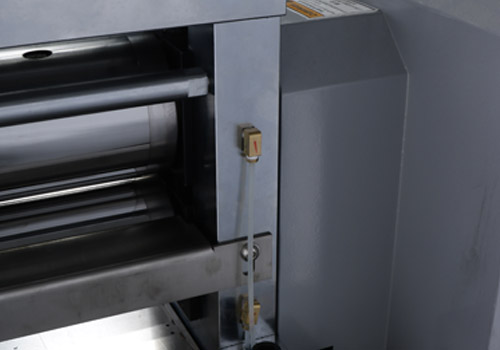


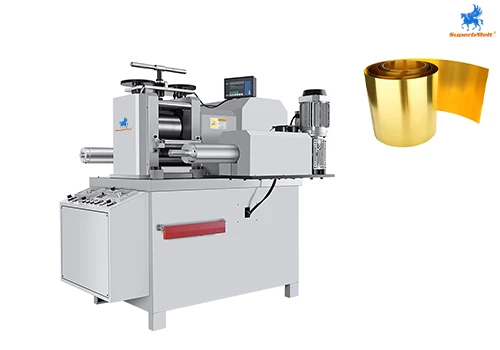
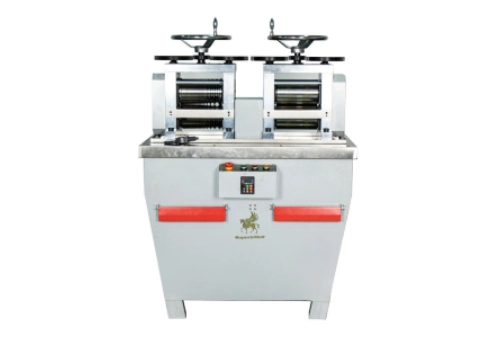
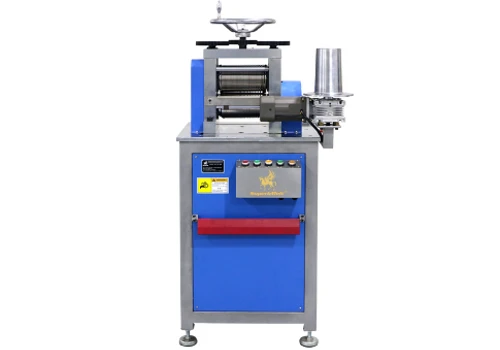
 © Copyright 2008-2021 Superb Electromachinery Co., Limited
© Copyright 2008-2021 Superb Electromachinery Co., Limited